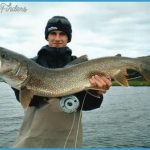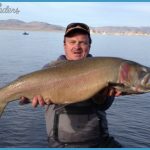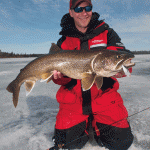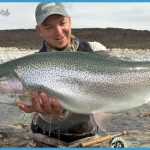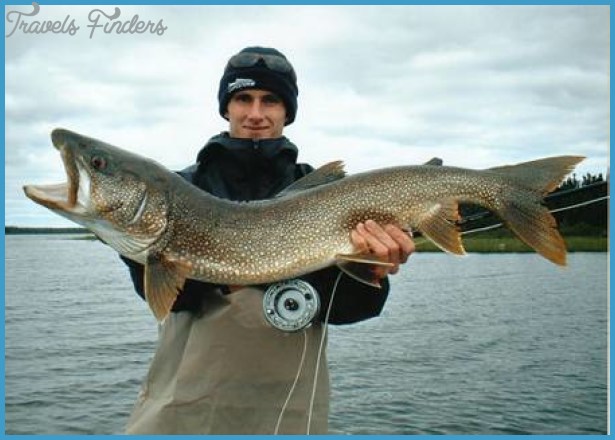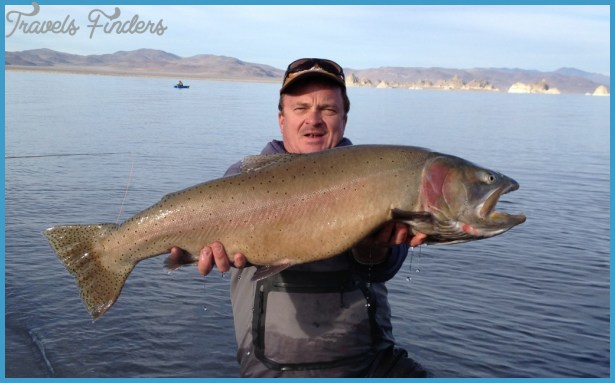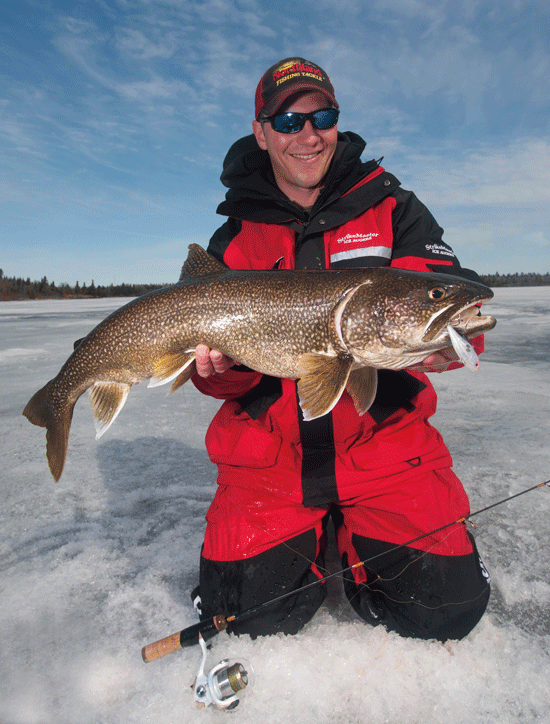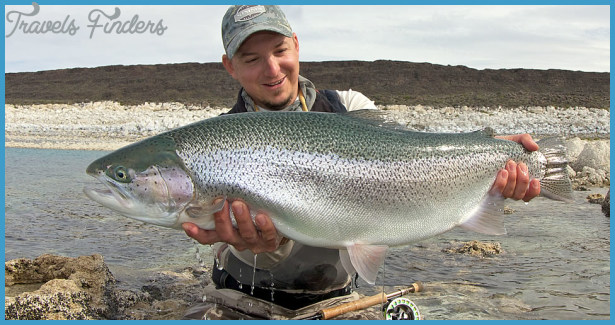Lake trout, Salvelinus namaycush, are called togue in Maine. The state record weighed 31.5 pounds and individuals up to 20 pounds are taken regularly, although specimens weighing 3 to 8 pounds are more common. Except for a short time in very early spring, when they are drawn to shallow water by spawning smelt, lake trout are fish of cold, deep water.
By and large, lake trout are fish of lakes, preferring a water temperature of about 50 degrees. For this reason, lake trout are found in deep water, the only place they can find suitable temperatures in summer.
Even if water temperatures are suitable, lakers will not go in shallow water on a bright day because their eyes are light-sensitive. This fact is often overlooked by eager fishers, but it will pay off in dividends if you stay away from the shallows on bright days. By following the same strategy, you can expect lakers to be in more shallow water around dawn; they will move to deeper water when the sun becomes bright.
Lake trout do not jump when hooked and rarely make any kind of fuss on the surface. They do put up a powerful, dogged battle. Anyone who has caught a laker of 7 or 8 pounds or more will agree that you just don’t reel them in like an old boot.
Lake trout feed almost exclusively on other fish, including other trout.
Techniques
Spin fishing – Spinning lures can be used to good effect for lake trout. Immediately after ice-out, lake trout are in relatively shallow water and can be taken on spoon-type lures such as Mooselook Wobblers and Dardevles. This can be done either from a boat or from the shore. Cast, allow your lure to sink to the bottom, and slowly reel, giving an occasional twitch of the rod tip to impart action. When the water warms, usually a month or so after ice-out, lake trout head for the cool depths and spinning techniques are no longer effective.
Use a medium-weight rod and reel and the largest lures your outfit can handle. Your rod should have plenty of backbone in order to set the hook in the toothy maw of a lake trout. Use at least 8-pound test line.
Bait fishing – Smelt are a prime source of bait, especially during the smelt runs. Large golden shiners up to 5 inches long and white suckers of a similar size are also good choices. Because lake trout are reluctant to go too far from the bottom after food, keep your bait on the bottom for the best results.
Still fishing, casting a baited hook and letting it lie motionless on the bottom, is the most effective way to employ bait. Still fishing can be tedious; sometimes you can go for hours or even an entire day without a bite. At other times, you can catch two or three fish in an afternoon. A boat with a fish locator helps to even the odds because you can at least be certain you are fishing in a spot that contains fish.
Use baitholder-style hooks in size 4 or 6 and above all, do not add any more weight to your line than is needed to keep the bait down on the bottom. Bell sinkers, rubber-core sinkers, and the like will only cause the lake trout to drop your bait. You want it to appear as natural as possible. If you have trouble with your minnow swimming to the surface, kill it. Lake trout will take a dead bait as well as a live one. You might even get more bites on a dead bait.
Fill your reel with at least 100 yards of 8-pound test monofilament, but
beware of anything over 10-pound test. Lake trout will avoid your bait if it is attached to a thick, stiff line.
Trolling – During open water fishing, most lake trout are taken by deep trolling techniques. The tackle used for lakers is the same as that used for landlocked salmon, except that lake trout prefer trolling spoons with copper or gold blades, not the chrome blades used for salmon. Lake trout anglers also use a single-blade spoon with a few red beads strung above it. These spoons are often as much as 8 inches long and 5 inches wide.
Size of bait is important. When trolling for salmon, a 3-inch minnow is about right, but lake trout like larger bait, even minnows 6 inches long and more. It would be difficult to find a minnow too large for lake trout.
Slow is the key to trolling for lake trout. A motor capable of smooth operation at the slowest trolling speeds is a must. Many anglers prefer electric motors because of the infinite number of speed adjustments. Go just fast enough so that your trolling spoon blades barely turn. At speeds this slow, your outfit will sometimes touch bottom and you will need to reel in and remove any debris. Remember that you need to be within a foot of the bottom anyway. If you do not bump bottom once in a while, you are not deep enough.
When a lake trout takes a trolled bait, you need to strike with all the force your tackle can stand. Lake trout have tough, bony mouths, and it requires considerable force to set the hook properly.
Some anglers use medium-weight spinning or bait casting gear along with a downrigger, rather than heavy tackle and lead-core line. You might use a dodger a few feet ahead of your bait. The bait should gently sway from side to side as you troll for lake trout, so check the action alongside your boat before you begin fishing. This is one of the few instances where you would not want the lure or bait too close to the dodger. The dodger should be used as an attractor only, not to impart action to your bait or lure. If you are fishing with a partner, have that partner bring the downrigger up as soon as you hook a fish so you can enjoy the battle without fear of your prize getting wound around your downrigger cable.
Lake trout are sometimes taken by anglers fishing for landlocked salmon with streamer flies. When conditions are right (proper water temperatures and overcast skies), lake trout can be found near the mouths of streams during a smelt run. This happy circumstance does not occur frequently, and when it does, it is of short duration. If you want to up your chances of taking a lake trout on a streamer with your fly rod, use a high-density sinking line. Don’t expect to take many lake trout this way, but be aware that the possibility exists.
Vertical jigging – This tactic was once widely known, but fell into disuse; it is only now regaining its popularity. Jigging with artificial lures, bait, or a combination of the two is an efficient and enjoyable way to fish for lake trout during the open water season or through the ice. Jigging can be done with any tackle, but most anglers prefer heavy spinning gear.
In days past, anglers jigged with a 12-inch-long strip of white flesh from the belly of a sucker. Sucker skin is tough, so the bait stays on the hook a long time. If you want to try this old method, use a thin strip of sucker belly and hook it at one end, making sure the hook point protrudes. Allow it to reach bottom and lift your rod about one foot, then drop it. The sucker belly will flutter on its way back down, attracting any lake trout that may be near.
Modern ice-fishing lures are ideally suited to summertime jigging, and are all solid producers of summertime lake trout. Some anglers add a bit of minnow or even a small strip of sucker belly to the jig hook, but you can still take fish without adding bait. If you can find an ice jig with glow-in-the-dark paint, buy it. If not, you might apply some glow paint to your existing jigs. When fishing in 60 or so feet of water, you need to do everything you can to make your jig visible.
Most anglers use a fish finder to locate groups of lake trout and then slowly drift over the schools. This eliminates all guesswork, but does not guarantee results. Lake trout are never pushovers.
Ice fishing – Ice fishing is probably the most popular method of fishing for lake trout. The fish tend to congregate under the ice, so a spot that produces one fish will usually be good for a few more. As the winter wears on, lake trout seek progressively deeper water; if they are in 45 feet of water in January, they may be in more than 100 feet of water at the end of February.
Tip-ups and live or dead minnows are standard fare for lake trout. No matter how deep the water is, always set your bait on the bottom. Veteran lake trout anglers will use the largest golden shiner they can find and kill it so it rests on the bottom where the trout can find it. Other good anglers insist on live smelt, but in fact both will take lake trout if they are fished on the bottom.
Anglers usually match their tackle to their quarry, but in lake trout fishing this is often a mistake. Your line must be relatively thin and very supple. If the line has been on the spool for a season, be sure to stretch it or even pull it through a bit of rubber to remove any tendency to coil. Stick to 8- or 10-pound test monofilament.
Use no additional weight if you can help it. It may take some time for your dead minnow to reach bottom without weight, but lake trout can detect the presence of sinkers and will reject a bait if they are the least bit suspicious. The use of a good, straight line and no weight are the two most important considerations when ice fishing for lake trout.
If you get a flag, don’t rush to the tip-up and begin pulling line. Lake trout sometimes take a long time to ingest a bait. Typically, a fish will run with the bait, drop it, and pick it up again before turning the bait to swallow it headfirst. Lake trout may run as much as 100 feet with a bait, so don’t set your lines any closer to each other than that or you may wind up with a tangled mess beneath the ice.
Best bets for Maine lake trout: Sebago Lake, Site 6; Beech Hill Pond, Site 47; Indian Pond, Site 67; and Millinocket Lake, Site 76.

